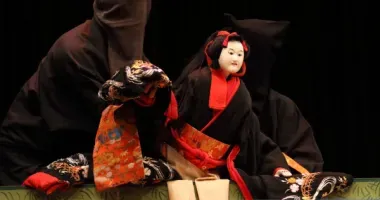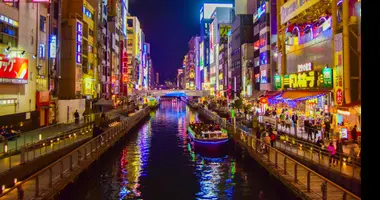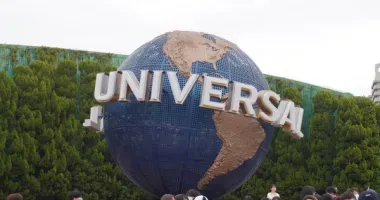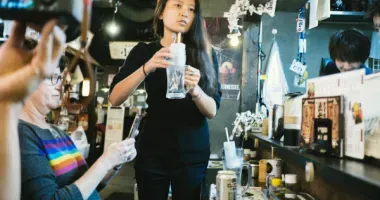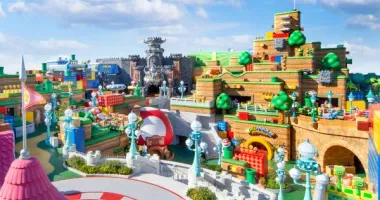Sakai Osaka Guide
Sakai: read a guide to the historic port of Sakai near Osaka famous for its ancient Mozu burial mounds.
Sakai: From Kings to Cutlery 堺市
Alan Wiren
 Sakai's hexagonal lighthouse is the oldest wooden lighthouse in Japan
Sakai's hexagonal lighthouse is the oldest wooden lighthouse in Japan
Now it is called Sakai City, but this place, just south of Osaka, preserves legacies that go back to a time before the idea of cities had come to Japan.
Some places remain mysterious while others are straightforward as a gun barrel. When civilization began to take shape here, the idea of writing had not arrived either. No records were left from that age, but what was left is grand.
Sakai is home to a grouping of kofun: ancient burial mounds, the tombs of kings. Known as the Mozu Burial Mounds, or Mozu Tombs, they became a UNESCO World Heritage Site in 2019. They rival the great pyramids in size and the curious, keyhole shaped tumulus, surrounded by a moat, seems to be unique to Japan. Sakai's necropolis includes twenty-one round, and five square kofun, and twenty that are keyhole shaped, including that of Emperor Nintoku which is one of the three largest funerary monuments on Earth.
 Mozu Burial Mounds seen from the air
Mozu Burial Mounds seen from the air
Kofun
Appreciating their grandeur requires some imagination. The tumulae now stand covered with trees, rather than presenting faces of raw stone, as when they were built in the third to the sixth centuries, and most cannot be entered, even by archeologists. Care of the kofun is entrusted to a ministry concerned with imperial property. As such, they are held sacred, not to be defiled by the intrusions of ordinary folk.
 Sakai Cycling Festival
Sakai Cycling Festival Myokokuji Temple in Sakai, south of Osaka
Myokokuji Temple in Sakai, south of Osaka
Sakai's Museums & Temples
A more in depth experience of the area's development is offered by the city's numerous museums and temples. The Sakai City Museum presents an overall view of its history from ancient to modern times, including artifacts from the limited investigations that have been allowed into the kofun.
The building of kofun left, in its wake, a technology that developed into a signature industry for Sakai: the forging of iron tools. While metallurgy shapes the character of the city even today, it was the evolving character of the city, the nation, and even the world around it, that determined the shapes of the metal objects it produced.
The area around Sakai grew in political significance as the government of Japan evolved. In the fourteenth century, Sakai became a well known producer of the samurai's iconic swords.
The little lighthouse, now a national historic site, that has stood on Sakai's shoreline since 1877, is a symbol of the city's role as a gateway for foreign culture and trade. Goldfish arrived here first, from China, in 1502.
 The historic lighthouse in Sakai
The historic lighthouse in Sakai
A few decades later, a Portuguese ship brought the first rifles to a trading post on a small, southern island (Tanegashima), and Sakai became a major manufacturer. Although carbines were eventually beaten out by front forks, as evidenced by the Bicycle Museum and a bicycle parade in the annual Sakai Festival in October, gun salutes and marksmanship displays are still featured in the festival as well.
 The Hamano Museum in Sakai is dedicated to the art of Japanese knives
The Hamano Museum in Sakai is dedicated to the art of Japanese knives
Tobacco Trade
Tobacco was introduced to Japan around the same time, and the knives that Sakai's blacksmiths made for cutting the leaves were of such high quality that the Shogunate made them the national standard.
In modern times they have turned their skills to cutlery. Nowadays chefs the world over have begun to covet the uniquely crafted kitchen knives of Japan, over ninety percent of which are hand made in Sakai.
The tiny Hamono Museum has videotaped presentations that describe the history, production techniques, and care of Japanese knives, and displays of the myriad forms they can take. With a gift shop the size of the museum itself, you should have no problem finding souvenirs. The museum offers repair services and hands-on experiences, as well.
 Senno Rikyu residence, Sakai, Osaka
Senno Rikyu residence, Sakai, Osaka
Senno Rikyu
In the hands of Japanese chefs, Sakai knives produce a cuisine that has, itself, gained international renown, and the city is host to the birthplace and residence of a shaper of that tradition. Senno Rikyu, serving as tea ceremony master for Oda Nobunaga and Toyotomi Hideyoshi, central figures in the reunification of Japan in the sixteenth century, laid foundations that continue to influence Japanese arts and philosophy to the present day.
You can visit the site of his residence, where the flagstone path and his well are preserved. His legacy is also honored at the temple, Nanshuji. There you will find a tea house of the simple, rustic style of Rikyu's later years, and his favorite washbasin.
 Nanshuji Temple, Sakai
Nanshuji Temple, Sakai
Myokokuji Temple
Myokokuji, another of Sakai's many temples, is famous for mysteries of honorable suicide and anthropomorphic plant life. In its main garden grows an impressive Japanese cycad, with multiple, twisting trunks, that is now a national monument.
Legend has it that Oda Nobunaga desired the plant as a symbol of his great power, but when it was brought to his castle at Azuchi, near Lake Biwa, the plant proved too great a challenge for the warlord.
It was soon reported that the cycad was moaning at night, saying, "Take me back to Sakai!" Nobunaga, bringing a brace of warriors, came to listen, and the cries so infuriated him he ordered his men to take to it with swords. The wounds gushed human-like blood, soaking the attackers.
Nobunaga gave in and sent the cycad back to Myokokuji where there have been no further reports of moaning or bleeding. Theories have been advanced with logical explanations, but why spoil the fun?
Visiting Myokokuji you will also find the severed hair, death poems, and spattered blood of samurai who committed ritual suicide on the temple grounds. They are victims of the Sakai Incident, a more modern and macabre mystery.
It is known for sure is that in 1868 eleven sailors and a midshipman from a French vessel, the Dupleix, were killed by Japanese mercenaries from the Tosa clan guarding the port. As an apology, eleven of the mercenaries committed seppuku before a representative of the French government at Myokokuji. What exactly the sailors were doing in the city and why the mercenaries chose to attack remain points of controversy.
 Sakai is famous for its knives, which are a symbol of the city
Sakai is famous for its knives, which are a symbol of the city
Seeing Sakai
Sakai offers so many opportunities to understand and enjoy Japanese culture that you might want to make your first stop at Houchigai Shrine. It was built on a spot where, in ancient times, the borders of three prefectures met.
The lines on the map have long since changed, but people still come here when in need of any kind of direction, be it romantic, spiritual, geographic, or otherwise. There is even a parking lot where automobiles may pray for a safe sense of direction.
A more secular approach would be to follow one of the preplanned walking tours outlined on sightseeing maps scattered throughout the city, or to visit the city's web site at www.city.sakai.lg.jp and plan a trip that will satisfy your own curiosity and tastes.
Access - how to get to Sakai
There are Nankai Line trains from Nanba Station to Sakai as well as the JR Hanwa Line from Tennoji Station to Wakayama.
Text + images Alan Wiren
 Sakai city map
Sakai city map Sakai Bicycle Festival
Sakai Bicycle Festival
